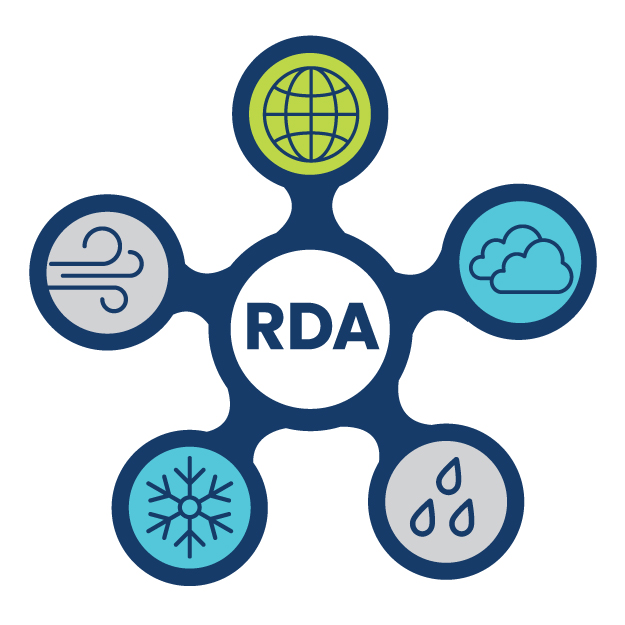
ERA-Interim Project, Single Parameter 6-Hourly Surface Analysis and Surface Forecast Time Series
d627002
| DOI: 10.5065/D64747WN
This historical dataset is recommended for ancillary use only and not as a primary research dataset. It has likely been superseded by a newer, improved dataset.
ERA-Interim represents a major undertaking by ECMWF (European Centre for Medium-Range Weather Forecasts) to produce a reanalysis with an improved atmospheric model and assimilation system which replaces those used in ERA-40, particularly for the data-rich 1990s and 2000s, and to be continued as an ECMWF Climate Data Assimilation System (ECDAS) until superseded by a new extended reanalysis. Preliminary runs indicated that several of the inaccuracies exhibited by ERA-40 such as too-strong precipitation over oceans from the early 1990s onwards and a too-strong Brewer-Dobson circulation in the stratosphere, were eliminated or significantly reduced. Production of ERA-Interim, from 1989 onwards, began in summer of 2006. (The period 1979-1988 was prepended in 2011.)
Through systematic increases of computing power, 4-dimensional variational assimilation (4D-Var) became feasible and part of ECMWF operations since 1997, paving the way to base ERA-Interim on 4D-Var (rather than 3D-Var as in ERA-40). Enhanced computing power also allowed horizontal resolution to be increased from T159 (N80, nominally 1.125 degrees for ERA-40) to T255 (N128, nominally 0.703125 degrees), and the latest cycle of the atmospheric model (IFS CY31r1 and CY31r2) to be used, taking advantage of improved model physics. ERA-interim retains the same 60 model levels used for ERA-40 with the highest level being 0.1 hectopascal. In addition, data assimilation of ERA-Interim also benefits from quality control that draws on experience from ERA-40 and JRA-25, variational bias correction of satellite radiance data, and more extensive use of radiances with an improved fast radiative transfer model.
ERA-Interim uses sets of observations and boundary forcing fields acquired for ERA-40 through 2001, and from ECMWF operations thereafter. Noteworthy exceptions include new ERS (European Remote Sensing Satellite) altimeter wave heights, EUMETSAT (European Organisation for the Exploitation of Meteorological Satellites) reprocessed winds and clear-sky radiances, GOME (Global Ozone Monitoring Experiment) ozone data from the Rutherford Appleton Laboratory, and CHAMP (CHAllenging Minisatellite Payload), GRACE (Gravity Recovery and Climate Experiment), and COSMIC (Constellation Observing System for Meteorology, Ionosphere and Climate) GPS radio occultation measurements processed and archived by UCAR (University Corporation for Atmospheric Research).
NCAR's Data Support Section (DSS) is performing and supplying a grid transformed version of ERA-Interim, in which variables originally represented as spectral coefficients or archived on a reduced Gaussian grid are transformed to a regular 512 longitude by 256 latitude N128 Gaussian grid. In addition, DSS is also computing horizontal winds (u-component, v-component) from spectral vorticity and divergence where these are available. Processing of single parameter 6-hourly surface analysis and surface forecast time series has been completed for January 1979 through December 2014 (inclusive), or at least 36 years, and will continue as ERA-Interim becomes available thereafter. Data is currently available via NCAR's High Performance Storage System (HPSS), or by delayed mode request which transfers files from the HPSS to our web server for internet download, or via direct internet download, or NCAR's GLADE file system.
Downloading/Accessing data from this dataset implies acceptance of ECMWF's Terms of Use
| Air Temperature | Albedo | Albedo | Cloud Frequency |
| Convection | Dew Point Temperature | Evaporation | Gravity Wave |
| Heat Flux | Ice Extent | Incoming Solar Radiation | Longwave Radiation |
| Maximum/Minimum Temperature | Outgoing Longwave Radiation | Planetary Boundary Layer Height | Precipitation Amount |
| Runoff | Sea Level Pressure | Sea Surface Temperature | Shortwave Radiation |
| Skin Temperature | Snow | Snow Density | Snow Depth |
| Snow/Ice Temperature | Snow/Ice Temperature | Snow Melt | Soil Moisture/Water Content |
| Soil Temperature | Sunshine | Surface Pressure | Surface Roughness |
| Surface Winds | Terrain Elevation | Total Precipitable Water | Tropospheric Ozone |
| Vegetation Cover | Vegetation Species | Water Vapor | Wind Stress |
Latitude Range: Southernmost=89.463S Northernmost=89.463N Detailed coverage information Detailed coverage information 0.703° x ~0.702° from 0E to 359.297E and 89.463N to 89.463S (512 x 256 Longitude/Gaussian Latitude)
 This work is licensed under a Creative Commons Attribution 4.0 International License.
This work is licensed under a Creative Commons Attribution 4.0 International License.